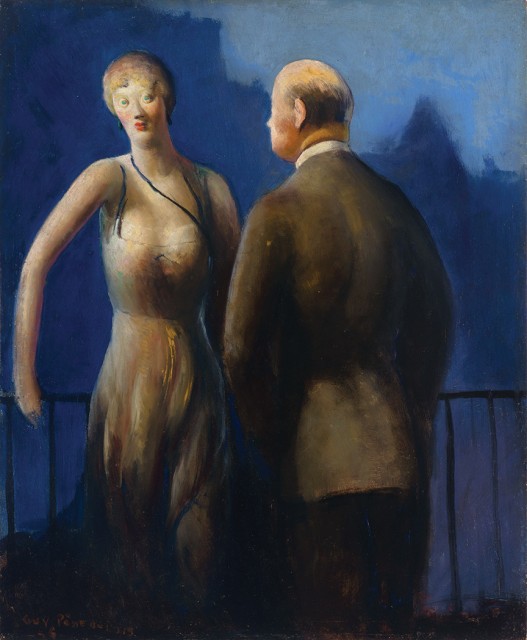Art Reflects Life, Life Reflects Art
05/04/2017 General

An enthusiastic member of the vibrant, convivial arts communities in New York, Westport, and in Paris, Guy Pène du Bois (American, 1884-1958) knew the artists about whom he wrote personally. He socialized with them, drank with them, and viewed their exhibitions. He reviewed these, just as contemporary critics of the day reviewed his.
The year 1913 was an especially significant one for Guy Pène du Bois, both as a painter and as a writer. Six of his paintings, including Waiter, 1910 [Collection Stamford Museum and Nature Center, Stamford, CT] were selected for the Armory Show, a landmark exhibition tbat introduced modern art to a broader American audience. The exhibition was held in New York at the 69th Regiment Armory from February 17 through March 16, and then traveled to the Art Institute of Chicago and, in an abbreviated form, the Copley Society of Art in Boston. Pène du Bois's work was well received by the art press, the critic Frank Jewett Mather, Jr., describing the painter as "superior and sardonic," praising the "characterfulness and discretion" of his work [Frank Jewett Mather, Jr. "Art: The Armory Exhibition. – II," The Nation, 96, no. 2489, Mar. 13, 1913, 267]. In the New York Press, William B. M'Cormick wrote that his "little canvases in the show are areek with life." [William B. M'Cormick, "Success of International Exhibition Disproves Statements That Art is Dead," New York Press, Mar. 2, 1913, section 2, p. 6]
Pène du Bois had worked as a journalist since 1906, accepting a position as a general reporter at The New York American, a newspaper that had employed his father until his death the same year. With time he evolved into a perceptive art critic, writing for several publications through his life. A member of the Association of American Painters and Sculptors, Pène du Bois played a key role in publicizing the Armory Show. As the editor of Arts and Decoration (for which he had begun writing in 1911, and for which he served as editor from 1913 to 1916, and again from 1917 to 1921, he devoted a special issue in March 1913 to the exhibition, praising "the great modern art of the day – and art that is thoroughly imbued with the intoxicating serum of life." ["The Spirit and the Chronology of the Modern Movement," Arts & Decoration 3, no. 5 (March 1913), 152]. He later took credit for ghost-writing several articles in the issue, including those by William Glackens, Robert Henri and Arthur B. Davies.
Pène du Bois described social encounters with friends in his journals, and wrote about their exhibitions in newspapers and magazines. One early journal entry mentions his visit to a show of the work of Edward Hopper. The two artists were lifelong friends and Pène du Bois was the best man at Hopper’s wedding. In Paris, where he rented his studio from the writer Ford Madox Ford, he spent evenings with Mahonri Young (whose work he had reviewed in 1918 for Arts and Decoration) and Paul Manship, who he described as "a craftsman."
Pène du Bois read extensively, and his journals record his responses. One of the first entries in his journal, on September 8, 1913, describes his reaction to Reminiscences of the South Sea Islands by John LaFarge: "He found there what Gauguin found at Tahiti and expressed it, in Anglo-Saxon confines, with the luxuriance, the wealth of color, of the latins. He has expressed a passionate love that I know never left him and that lives today, perhaps, more in his pictures than his writing. His palette, deep and reverberant, lent itself readily to the land of color, gave the depth of its happiness and the depth of its sorrow." Years later he would review the artist's work in "The Case with John La Farge," The Arts, 17, Jan. 1931, p. 277.
In 1922 Pène du Bois wrote about himself, from the perspective of a critic looking at an artist: "Of these two, critic and painter, the painter alone is idealistic. He began life [as] an idealist, a real one. He continues to be a real idealist. It is for that reason that in his satire there is something akin to a bite. But it is not from bitterness. There can be a love of the humanness in fault. People are all right. They are ludicrous only in the badges they wear, badges that are tokens of devotion to one ideal or another…. The bitterness other critics speak of is bosh…. He has always been a little afraid to be led into a love of art. This at life’s expense." ["Guy Pène du Bois by Guy Pène du Bois," International Studio, Jun. 1922, vol. 75, pp. 242-246]
Pène du Bois authored several monographs on the work of his peers for a series published by the Whitney Museum of American Art, an institution with which he was closely affiliated. Royal Cortissoz, author of a 1931 monograph on Pène du Bois for the same series wrote of his one-time assistant, "He was no imitator in his youth and he is no imitator in his prime. It is not enough to say that this is because he knows how to paint. It is also because he uses his brains. His art is life seen though a temperament, through a mentality. It is a vital thing." [p. 11]
Impressionist & Modern Art
Including Works by Guy Pène du Bois from the Collection of Willa Kim and William Pène du Bois
Auction: May 10, 2017 at 11am
Exhibition on view May 6-8, and by appt on May 9.